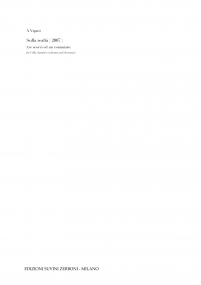From Joyous Leaves
concerto for piano and chamber orchestra
17,51 €
Digital version (+0,00 €) instant download
Printed format (+21,40 € printing and shipping). Colissimo7-14 days aprox.
When you buy a score, you can contact the composer right here!
Specifications
Region
Oceania
Estimated Duration
20 - 25min
Date
2015
ISMN : 979-0-2325-1786-5
In Stock
Notes on this piece My association with the music of Nigel Butterley has been a long and rewarding one. I first came to know it in my early twenties, though attending and taking part in performances of such works as the choral cycle There Came a Wind Like a Bugle and the opera Lawrence Hargrave Flying Alone: my exposure to these works had an important formative influence on my development as a composer. More recently I have written about his music in more and less formal contexts, including most recently a book for Wildbird Press. It has therefore been a pleasure and a privilege to write this concerto in his honour for this eightieth birthday celebration.
As the work’s title hints, it draws its inspiration and materials from the solo piano work Uttering Joyous Leaves, which has long been a particular favourite of mine, for me it represents quintessential Butterley, in distilled form. In the process of composition, resonances of other Butterley works came to mind – notably his own extraordinary piano concerto Explorations, seldom performed since its 1970 premiere, and the delicately resourceful scoring of chamber works such as The Owl and Orphei Mysteria.
Uttering Joyous Leaves in its entirety provides the framework for From Joyous Leaves, stretched out so it takes five times as long to play. The lengthening, however, is not uniform: thirteen individual bars spread across the score – corresponding to the entry and exit points of the soloist in my concerto – appear at their original speed, while the proportions gradually expand and then contract between these points. The result is an oscillating process, in which Butterley is always present but comes to the surface only periodically. The intricate structural repetitions of the original are consequently distorted, with the same material placed at different apparent distances from the listener in the course of the work.
Two further structural layers are superimposed on this Butterley palimpsest. The first concerns the deployment of the ensemble, section by section: this is clearest in the isolation of string timbres (three violas) at the opening, the four brass players at the midpoint, and tuned percussion (including celesta) at the end, but elsewhere it generates overlapping waves of instrumental colour, with very few tutti passages. The second is a succession of invented harmonic structures, derived from 22 notes on the piano which are prepared – a further aspect of homage, in this case to Butterley’s long association as a performer with the prepared-piano works of John Cage.
The coexistence of so many different levels of organization may suggest a work of forbidding complexity and density, but the way these levels interact in the music is much more playful and spontaneous in manner. There is no programmatic narrative to From Joyous Leaves, its concerns are purely musical, creating a dialogue between Butterley’s style and my own.
Add to a playlist
- Login to create your own lists
As the work’s title hints, it draws its inspiration and materials from the solo piano work Uttering Joyous Leaves, which has long been a particular favourite of mine, for me it represents quintessential Butterley, in distilled form. In the process of composition, resonances of other Butterley works came to mind – notably his own extraordinary piano concerto Explorations, seldom performed since its 1970 premiere, and the delicately resourceful scoring of chamber works such as The Owl and Orphei Mysteria.
Uttering Joyous Leaves in its entirety provides the framework for From Joyous Leaves, stretched out so it takes five times as long to play. The lengthening, however, is not uniform: thirteen individual bars spread across the score – corresponding to the entry and exit points of the soloist in my concerto – appear at their original speed, while the proportions gradually expand and then contract between these points. The result is an oscillating process, in which Butterley is always present but comes to the surface only periodically. The intricate structural repetitions of the original are consequently distorted, with the same material placed at different apparent distances from the listener in the course of the work.
Two further structural layers are superimposed on this Butterley palimpsest. The first concerns the deployment of the ensemble, section by section: this is clearest in the isolation of string timbres (three violas) at the opening, the four brass players at the midpoint, and tuned percussion (including celesta) at the end, but elsewhere it generates overlapping waves of instrumental colour, with very few tutti passages. The second is a succession of invented harmonic structures, derived from 22 notes on the piano which are prepared – a further aspect of homage, in this case to Butterley’s long association as a performer with the prepared-piano works of John Cage.
The coexistence of so many different levels of organization may suggest a work of forbidding complexity and density, but the way these levels interact in the music is much more playful and spontaneous in manner. There is no programmatic narrative to From Joyous Leaves, its concerns are purely musical, creating a dialogue between Butterley’s style and my own.
Instrumentation
piccolo|alto Flute|English Horn|Clarinet|Bass clarinet|bassoon|Horn (French Horn)|piccolo Trumpet|Trumpet in C|Trombone|Percussions (2)|Piano |Violin I|Violin II|Viola|Cello|Double bass
Score Details
Format - A3 / Tabloid
Pages - 100
Pages - 100
Similar Pieces





